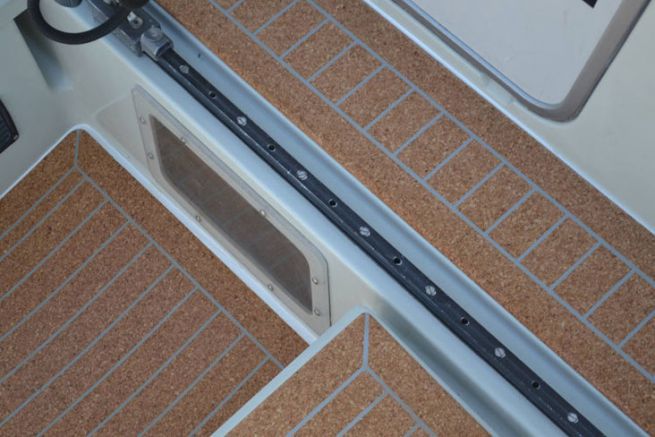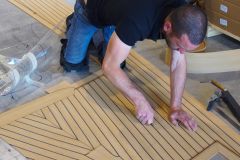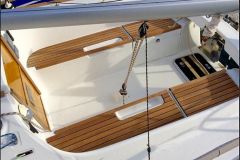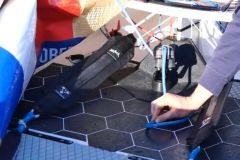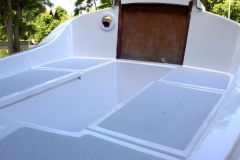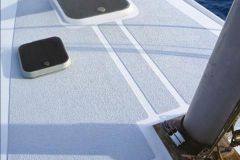The Seacork, ideal for a boat deck
For the bridge, this product is based on the natural properties of cork. It has only advantages compared to the competition (natural or synthetic teak):
- Highly effective anti-slip
- Comfort underfoot. Unlike teak, cork does not heat up and does not burn your feet when sailing in the sun.
- Ecological and natural
Made from crushed cork scrap, the Seacork is assembled with a polyurethane resin and highly compressed. - Easy maintenance and cleaning
The surface of the Seacork doesn't get saturated with dirt. Cleaning with a simple brush is easy. - Significantly lighter than other products
In 8 mm thickness, Seacork weighs 3.2 kg/m2. By way of comparison, PVC decks weigh 6 kg/m2 and natural teak weighs 7 to 8 kg/m2. - Thermal, sound and vibration insulation
Cork is a perfect insulator. Whether it is to prevent heat from penetrating or to keep out the cold, Seacork provides a good thermal barrier. The same goes for noise and vibrations. - Total freedom of installation for the design or layout
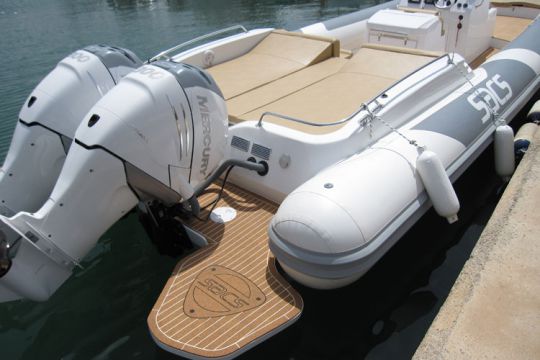
Application and maintenance within everyone's reach
The application of Seacork is easy, as this product can be cut with a simple cutter. It can be glued on any surface: an old teak deck (no need to remove the old battens), diamond point, a metal deck... The joints can be black, white or grey. For heat, it is advisable to avoid black (although more classic) and to take a light colour which will heat less.
In the 15 years that the Seacork has been in existence, there have been no problems with after-sales service. Some owners appreciate keeping the original colour and regularly sand the deck surface. But if the lighter colour is not disturbing, the Seacork does not require any special maintenance. Only a coat of saturator, once the wood is in place, prevents stains from penetrating the wood.

Projected cork
Seacork now offers projected cork. This is a cork granulate combined with acrylic resin and wood glue that is projected onto the walls of the boat. Delivered ready to use, this cork is projected with a plastering gun (a kind of paint gun with a large nozzle). It is a non-solvent-based product and does not pollute when applied.
On metal boats (widely used on aluminium boats), this design allows you to reach every nook and cranny (structure, beam, beam...) and offers insulation that perfectly fits the hull or deck. A minimum of 2 mm of product is required for it to begin to be effective, but some shipyards like Olbia do not hesitate to apply it in 6 mm thickness.
With sprayed cork, no more problems of thermal bridge. This application improves interior comfort and life on board. Cork is particularly appreciated for eliminating condensation phenomena (both hot and cold). It thus helps air conditioning as well as heating.
This cork can also be used as a decorative element. It can be tinted (50 colours) and replace a glaze. Projected, it dresses the hull.
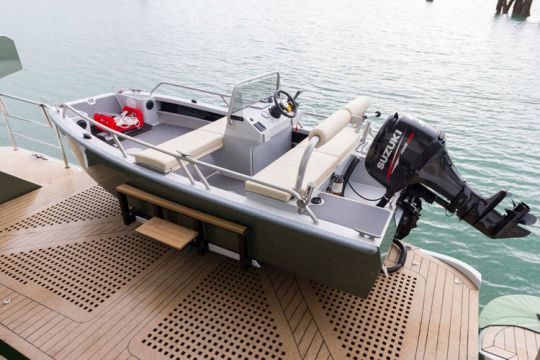
Seacork, a single brand for 2 products
It is under its brand Seacork (a French institution) that the Seacork is developed :
Seacork Deck for bridges and Seacork Hull for projected cork. Building sites are more and more interested in the characteristics of the product which combines efficiency with the notion of ecology.
